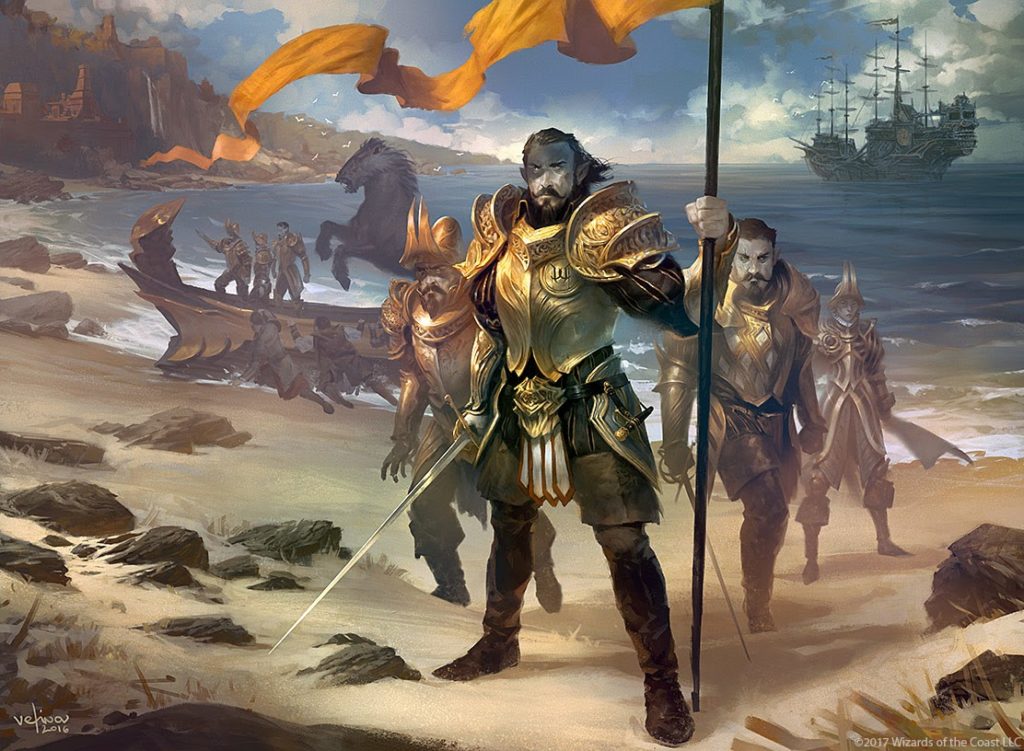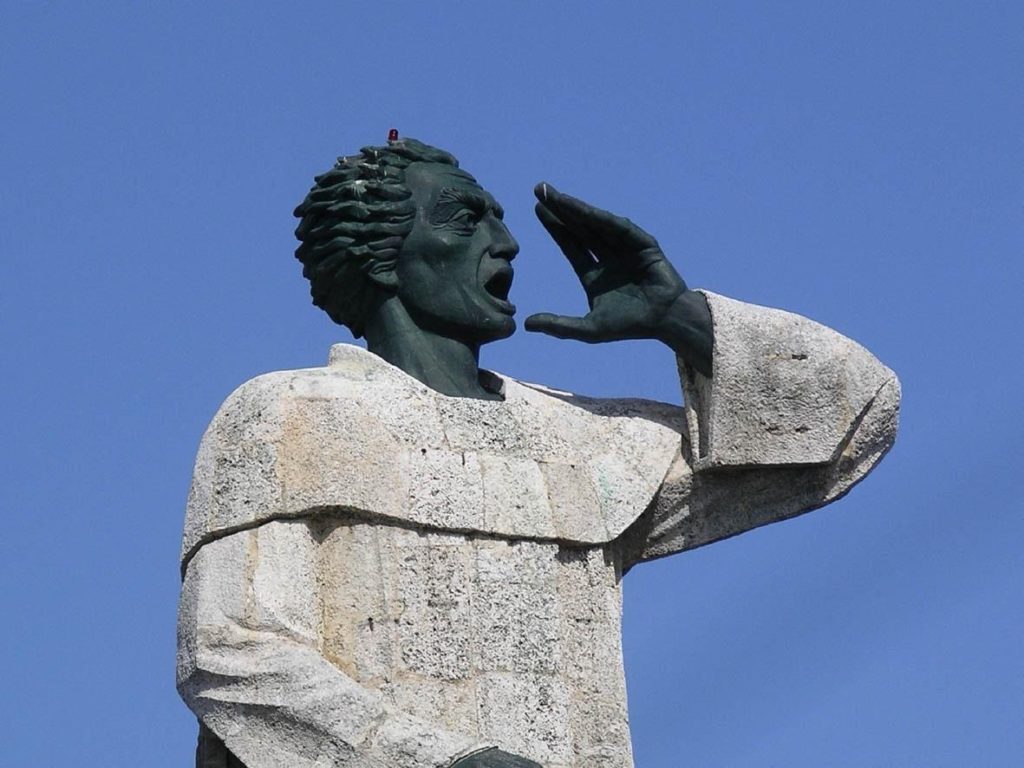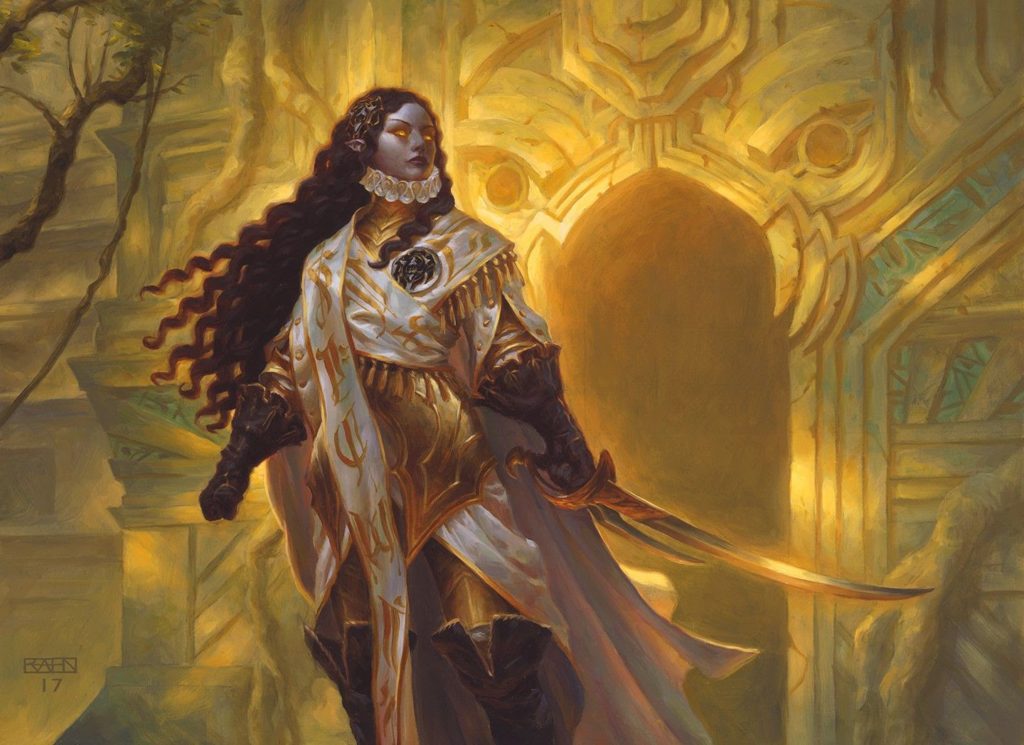Today, Jacob takes his Magic & Meaning series to the shores of Torrezon. What inspired Ixalan, Vito, and the conquest of the Legion of Dusk?
“In order to gild a very cruel and harsh tyranny that destroys so many villages and people, solely for the sake of satisfying the greed of men and giving them gold, the latter, who themselves do not know the faith, use the pretext of teaching it to others and thereby deliver up the innocent in order to extract from their blood the wealth which these men regard as their god.”
—Bartolomé de Las Casas
In my last essay, I took at look at what Core Set 2021 offers us in terms of a reflection on Teferi and our perception of time during this pandemic. Couched in terms of “synchronicity,” I reflected upon how, despite these cards having been produced too far in advance to be intentionally commenting on the year we’re having, the fact that Magic draws deeply from real world cultural motifs virtually guarantees overlaps with the real world that move beyond the source material and resonate in new ways with our current moment.
Wouldn’t you know it, there’s more to say about Core Set 2021. This week, I want to explore the lore of a card that I’ve loved drafting on Arena and have already found a slot for in my Edgar Markov EDH build: Vito, Thorn of the Dusk Rose. As Kristen Gregory notes in a previous article, Vito is a fantastic card that puts Sanguine Bond on a body for three mana, helping life gain strategies and vampire tribal decks like Edgar Markov find even more ways to close out a game. He’s also a vampire priest of the Legion of Dusk, the (quite literally) bloodthirsty conquistadors from Ixalan’s continent of Torrezon.
I write about this card in part because I absolutely love it, but also because “bloodthirsty conquistadors” are indeed a “thin metaphor,” as Alison Lührs has put it—especially in this summer of comeuppance for institutions and edifices that uncritically enshrine America’s racist, colonial past. In my own city of Chicago, the police recently used violence to defend a statue of Christopher Columbus from a crowd of activists. The mayor has since had all public statues of Columbus removed; many statues have faced similar fates all over the United States. By putting the Legion of Dusk in juxtaposition with the legacy of colonization in the Americas, I hope to do two interrelated things: the first is to use our legacy of colonialism in especially the southern U.S. and Latin America to help us understand characters like Vito, Elenda, the Dusk Rose, Mavren Fein, and Vona. The second purpose of this essay is simply to do the reverse of the first—to explore what these characters from Magic’s lore can teach us about colonialism and its legacy.
For God, Gold and Glory
As I alluded to above, in the 2017 run-up to the release of Ixalan, Blake Rasmussen and Alison Lührs sat down to talk about the real-world inspirations for the set. Lührs mentions, as she begins to talk about doing a Mesoamerican setting, that to use this inspiration means ”actively deciding to tackle the imperialist baggage that comes along with it. The nice thing about fantasy is we get to look at the real world and decide what stays and what goes . . . .” In so doing, Wizards of the Coast chose to cast the conquistador faction, the vampiric Legion of Dusk, not as a colonizing power, but as co-competitors in a race to claim (or re-claim) The Immortal Sun.
Chasing this El Dorado or Fountain of Youth-like MacGuffin, the vampires are sailing east to Ixalan from their home of Torrezon aboard ships that resemble floating gothic cathedrals. Our friend Beck Holden did a wonderful job summarizing some of the parallels that 15th and 16th Century Spain shares with Torrezon back in 2017, but for our part today I want to focus on the “delightfully thin metaphor” of vampire conquistadors with Spanish and Italian names landing in a lush Mesoamerican-inspired continent in the West. As goes the religious legacy of the conquistadors, the metaphor is thin indeed. Consider obvious parallels to the Christian rite of baptism, language of heretics, the hierarchical structure of the Church of Dusk, which has its own Pontifex; even the theological emphasis on the saving power of blood and the value of making a gift of self (self-sacrifice). The Church of Dusk just might be the in-game religion that most closely resembles real, historical Catholicism in flavor and rhetoric—though I’ll have more to say on that in a future essay.
This brings a sort of conflict in Alison Lührs’s words into relief: while the Legion of Dusk may not strictly be invaders from an officially Roman Catholic kingdom, they certainly look the part. The legacy of colonialism and the violence it brought to the Americas hangs over the aesthetics of the set like a (very flavorful, in spite of any reservations) funeral pall. Legion’s Landing sends echoes of the classic line attributed to Christopher Columbus, “I claim this land in the name of Spain!” The armored vampire, presumably Adrian Adanto of Lujia, even has a flag.

Legion’s Landing by Svetlin Velinov
Columbus, as most of us know, initiated what would become the Spanish conquest of the Americas, begun on Hispaniola with the subjugation of the Taíno people. Dominican friars, moved with fervor to share the gospel, came to the island on subsequent voyages. While some religious officials were among the most egregious in rationalizing the abuse of the Caribbean natives, the friars on Hispaniola were horrified. On the 21st of December, 1511, in the presence of Christopher Columbus’s own son, Diego, Friar Antonio de Montesinos preached an impassioned sermon criticizing the Spanish colonists and denouncing the abuse of the natives of Hispaniola:
In order to make your sins known to you I have mounted this pulpit, I who am the voice of Christ crying in the wilderness of this island… This voice declares that you are in mortal sin, and live and die therein by reason of the cruelty and tyranny that you practice on these innocent people.
Tell me, by what right or justice do you hold these Indians in such cruel and horrible slavery? By what right do you wage such detestable wars on these people who lived mildly and peacefully in their own lands, where you have consumed infinite numbers of them with unheard of murders and desolations? Why do you so greatly oppress and fatigue them, not giving them enough to eat or caring for them when they fall ill from excessive labors, so that they die or rather are slain by you, so that you may extract and acquire gold every day? […] Are they not men? […] Are you not bound to love them as you love yourselves?
His sermon outraged the settlers so much, they formed a mob and went to the Friars’ priory to protest, demanding a retraction the following Sunday. Instead, the following Sunday, the friars doubled down. This obstinate commitment to the rights of the natives led to the recall of the Dominican friars to Spain, where they were able to plead their case and achieve some minor accommodations for the natives’ plight. In 1540, on an expedition into Venezuela, Montesinos would be murdered by a colonizer for his efforts to prevent the exploitation of the natives.

Monumento Fray Antonio de Montesinos by Antonio Castellanos Basich; Santo Domingo, Dominican Republic
Suspended in Dusk
The Lore of Ixalan both appropriates and repudiates this real world history in creative ways. By putting the Legion of Dusk in the shoes of explorers like Walter Raleigh, rather than colonizers like Christopher Columbus and Hernando Cortez, Ixalan uses the aesthetic trappings of the Spanish Conquest without directly recapitulating the narrative of colonization. Somewhere between saint and savior, Elenda is an archetypal hero who gives rise to legend and inspired faith—she finds the “fountain of youth.” Rather than a holy relic, this fountain is a source of dark magic that grants her immortality—immortality that is crucial to her sacred mission to guard the Immortal Sun. After returning to Torrezon to share this gift with others so they may join in this sacred duty, she sails back to Ixalan and is not heard from for centuries.
In her absence, the true meaning of Elenda’s gift of vampirism becomes distorted in myth. Rather than understanding their vampirism as a burden accepted as a means to eternally seek and protect Azor’s artifact, the Legion of Dusk view the Immortal Sun as that which will free them from the burden of vampirism, granting them immortality without the need for blood. Like any religious group, the vampires of Torrezon are attracted to this quest for various reasons: Vona, Butcher of Magan reminds us much of historical figures like Hernando Cortez, who seek conquest and glory. Mavren Fein, Dusk Apostle, one of Elenda’s first converts, is on a spiritual quest like the Dominican friars. When Vona and Mavren Fein find the Tomb of the Dusk Rose, their reactions recall those early events like I mentioned above: Mavren Fein, believing the truth of his revered saint, repents of his mistakes; Vona, more loyal to the cause she’s internalized than the original impetus for the cause, has to be chastened. In this, Mavren Fein reminds me much of Montesinos and other friars who, when facing reality, saw the truth of the matter and put themselves on the side of the Good.

Elenda the Dusk Rose, by Chris Rahn
Upon their return to Torrezon, however, not all accept Elenda’s return with reverence or docility. When Elenda and Mavren Fein testify to the disappearance of the Immortal Sun and preach humility, Vito grows indignant and symbolically rebukes the living saint, spilling a carafe of blood across the floor of a church. We can imagine the same indignance in the congregation in the wake of Montesinos’s 1511 sermon, in the wake of an excommunication from Las Casas.
We can also see these emotions on display in American political discourse in 2020. In many cases, what BIPOC activists and allies are asking other Americans to do is not so different from what Montesinos, or Ixalan’s Elenda asked others to do: grapple with the reality that we’ve misunderstood or been blind to the source of our own convictions, and that we’ve internalized a distorted, sanitized version of our own national mythology.
In this essay, I’ve explored features of Alison Lührs’s “thin metaphor” of Ixalan’s vampire conquistadors as a means of understanding the legacy of Spanish conquest; and I’ve explored two figures—Columbus and Montesinos—as a lens for understanding the leading vampires of Ixalan. Lührs and her team tell a compelling tale: the search for the Immortal Sun has been misunderstood, and the lust for glory and domination is ultimately rebuked in favor of service and humility. Vito, Thorn of the Dusk Rose represents the “fail state” for Elenda’s return: rejection of the Church of Dusk’s original purpose and the embrace of its distortion.
In our own history, the European colonization of the Americas was not stopped by the entreaties of a few friars pleading with monarchs. Thus far, we are left to wonder what the outcome might be for the people of Magic’s continent of Torrezon. Will Vito’s rejection of Elenda’s return foment further conflict, or will the saint’s message be accepted? Likewise we have yet to see how this summer of unrest will resolve in cities across the United States. We have a choice about how and whether we want to recapitulate historical narratives. What kind of story will we choose to write?
For further reading:
Alison Lührs, The Race, Part 1.
Robert Ellsberg, “Las Casas’ Discovery: What the ‘Protector of the Indians’ found in America,” America Magazine (Nov 5, 2012).
Bartolomé de Las Casas, A Short Account of the Destruction of the Indies (Penguin Classics, 1542 / 1999).
Jacob Torbeck is a researcher and instructor of theology and ethics. He hails from Chicago, IL, and loves playing Commander and pre-modern cubes.

